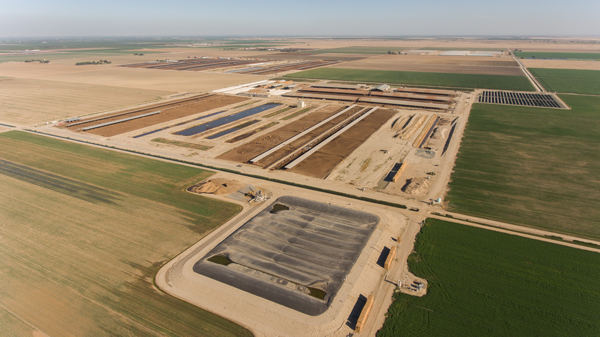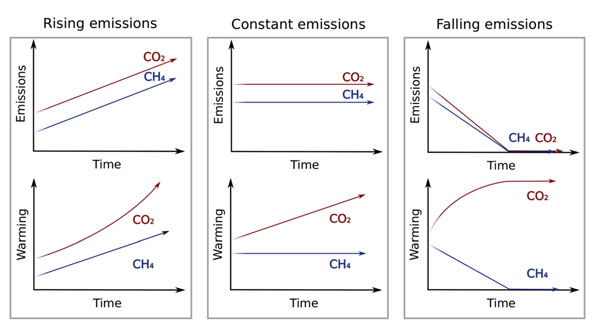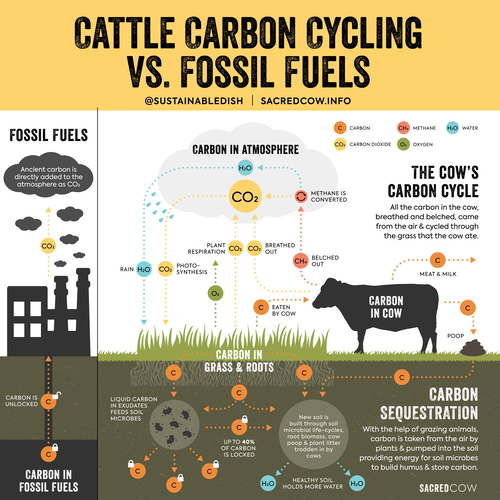THREAD: I have BIG news! It& #39;s now evident that California dairies are on the path to climate neutrality. This is no longer just a concept. Once we start #rethinkingmethane, U.S. animal agriculture WILL become a leader in sustainability & climate mitigation. Let& #39;s unravel. 1/
We can now say, the amount of methane produced by CA dairy farms is less than it was in 2008. This means more methane is being broken down in the atmosphere than is being emitted, leading to less methane in the atmosphere & less warming. 2/
Contrary to popular belief, cattle are doing their part in the fight against climate change. I& #39;m eager for policymakers to use CA dairy as an example of why understanding the details in the differences of greenhouse gas behavior matters when discussing climate impacts. 3/
The science on livestock emissions has been widely mischaracterized due to current standards, which can’t paint a full picture on methane. This will change: Today, in collab with @ErmiasKebreab & @DairyCares, a white paper the @UCDavisCLEAR and I have been working on is out. 4/
FYI– white papers are reports used to inform readers on complex issues & solutions. The report covers a case study where a current metric (GWP) & a proposed metric (GWP*) were applied to compare the climate impacts of methane emissions from U.S. cattle production. 5/
The report further focused on understanding how technological advances in California dairies have increased efficiency & productivity & helped mitigate methane emissions in the process. It suggests CA dairy farms are on the path to climate neutrality b/c of these practices. 6/
So how did we reach these conclusions? It really comes down to the acknowledging AND properly accounting for the different behaviors of long-lived climate pollutants (LLCPs), such as carbon dioxide (CO2), & short-lived climate pollutants (SLCPs), such as methane (CH4). 7/
LLCPs & SLCPs behave differently in the atmosphere, which is why the life cycles of pollutants vary. Here’s some background: https://clear.ucdavis.edu/news/greenhouse-gas-emissions-what-difference-between-stock-and-flow-gases">https://clear.ucdavis.edu/news/gree... 8/
To be clear: CH4 is potent – 28x more potent than CO2 & we need to reduce it. But biogenic carbon from livestock doesn& #39;t warm the same as fossil carbon. Biogenic CH4 is  https://abs.twimg.com/emoji/v2/... draggable="false" alt="♻️" title="Universelles Recycling-Symbol" aria-label="Emoji: Universelles Recycling-Symbol"> carbon & remains in the atmosphere for about 12 years. I wrote a
https://abs.twimg.com/emoji/v2/... draggable="false" alt="♻️" title="Universelles Recycling-Symbol" aria-label="Emoji: Universelles Recycling-Symbol"> carbon & remains in the atmosphere for about 12 years. I wrote a  https://abs.twimg.com/emoji/v2/... draggable="false" alt="🧵" title="Thread" aria-label="Emoji: Thread"> about this:
https://abs.twimg.com/emoji/v2/... draggable="false" alt="🧵" title="Thread" aria-label="Emoji: Thread"> about this:
https://twitter.com/GHGGuru/status/1294270569890713601?s=20">https://twitter.com/GHGGuru/s... 9/
https://twitter.com/GHGGuru/status/1294270569890713601?s=20">https://twitter.com/GHGGuru/s... 9/
Current measurements only account for CH4 emitted by livestock, but not its atmospheric removal. This graphic illustrates the climate impacts of CH4 emissions under three different scenarios: increasing, constant & decreasing CO2 & CH4 emissions. 10/
If methane emissions increase, so will warming. This is because more is being emitted than destroyed. But If emissions are constant, this leads to neutral warming b/c the amount emitted equals the amount destroyed and thus no additional warming joining the atmosphere. 11/
Here’s the kicker – If methane emissions are LESS than the amount being destroyed, there will be temporary COOLING of the current atmosphere. CA dairies are evidence that this IS achievable... 12/
... Ongoing projects will result in a 25% reduction in manure-related methane emissions: https://twitter.com/UCDavisCLEAR/status/1274058501262721024?s=20">https://twitter.com/UCDavisCL... 13/
The takeaway is this: The rate of change in emissions determines the warming impact of methane on the climate – how much more or less is being emitted over time – not its atmospheric concentration. 14/
What do we do with this info? In short, we must reconsider the metrics for quantifying the climate impacts of methane & CHANGE POLICY. The traditional method, GWP – or Global Warming Potential – uses a scale equating different GHGs to CO2. But it has limitations with SLCPs. 15/
Since GWP is a CO2e, it can only be positive, always indicating a warming effect. If you recall, CO2 is a LLCP. Therefore, it builds in the atmosphere, contributing new/additional warming for an indefinite period of time. It& #39;s not constantly being destroyed, like CH4 (SLCP). 16/
So, GWP overestimates the climate impacts of methane caused by constant or decreasing emissions & overlooks opportunities for climate mitigation. But there’s a solution. An alternative method, GWP* has recently been proposed as supplementary to GWP. 17/
GWP* – proposed by a group of scientists including @UniofOxford’s Dr. Myles Allen, Dr. John Lynch & @civiltalker, as well as @VicUniWgtn& #39;s @ClimateFramo – doesn’t convert GHG emissions into a CO2 equivalent...18/
… & allows for either a positive or negative, to indicate warming or cooling. It’s designed to reflect the impact of SLCPs. As @ClimateFramo puts it:
https://twitter.com/ClimateFramo/status/1274627300600897536?s=20">https://twitter.com/ClimateFr...
19/
https://twitter.com/ClimateFramo/status/1274627300600897536?s=20">https://twitter.com/ClimateFr...
19/
Adopting GWP* brings forth a scientific fact: cattle are a short-term cooling solution & can temporarily curb climate change. BUT this can& #39;t come at the expense of long-term solutions for fossil fuel emissions. https://twitter.com/ClimateFramo/status/1274919400332615680?s=20
20/">https://twitter.com/ClimateFr...
20/">https://twitter.com/ClimateFr...
We need to call on our policymakers to make way for animal agriculture in the path toward climate neutrality. There’s an entire industry willing to do their part to help curb warming, but they need support. Here’s the white paper in full: http://bit.ly/MethaneCowsClimateChange">https://bit.ly/MethaneCo... 21/
And in case you missed it, here’s the “Rethinking Methane” video produced by @UCDavisCLEAR. Be sure to follow the CLEAR Center here on Twitter & on Facebook. Please RT this thread & share our video with: #rethinkingmethane! 22/22
CC: @ucanr @ucdavisCAES

 Read on Twitter
Read on Twitter




